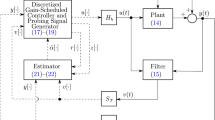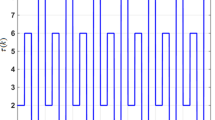Abstract
Recently, there has been a great deal of attention in a class of controllers based on time-varying gains, called prescribed-time controllers, that steer the system’s state to the origin in the desired time, a priori set by the user, regardless of the initial condition. Furthermore, such a class of controllers has been shown to maintain a prescribed-time convergence in the presence of disturbances even if the disturbance bound is unknown. However, such properties require a time-varying gain that becomes singular at the terminal time, which limits its application to scenarios under quantization or measurement noise. This chapter presents a methodology to design a broader class of controllers, called predefined-time controllers, with a prescribed convergence-time bound. Our approach allows designing robust predefined-time controllers based on time-varying gains while maintaining uniformly bounded time-varying gains. We analyze the condition for uniform Lyapunov stability under the proposed time-varying controllers.
Access this chapter
Tax calculation will be finalised at checkout
Purchases are for personal use only
Similar content being viewed by others
Notes
- 1.
In the spirit of Filippov’s interpretation of differential equations, solutions of (3) are understood as any absolutely continuous function that satisfies the differential inclusion obtained by applying the Filippov regularization to \(\textbf{f}(\bullet , \bullet )\) (See [9, Page 85]), allowing us to consider \(\textbf{f}(\bullet , \bullet )\) discontinuous in the first argument. In the usual Filippov’s interpretation, it is assumed that \(\Vert \textbf{f}(\textbf{x}, t)\Vert \) has an integrable majorant function of time for any \(\textbf{x}\), ensuring existence and uniqueness of solutions in forward time. However, in this work we deal with \(\textbf{f}(\textbf{x}, t)\) for which no majorant function exists, but existence and uniqueness of solutions are still guaranteed by an argument similar to [2]. In particular, existence of solutions follows directly from the equivalence of solutions to a well-posed Filippov system via the time-scale transformation.
References
Aldana-López, R., Gómez-Gutiérrez, D., Jiménez-Rodríguez, E., Sáanchez-Torres, J.D., Defoort, M.: Enhancing the settling time estimation of a class of fixed-time stable systems. Int. J. Robust Nonlinear Control 29(12), 4135–4148 (2019). https://doi.org/10.1002/rnc.4600
Aldana-López, R., Gómez-Gutiéerrez, D., Jiménez-Rodríguez, E., Sáanchez-Torres, J.D., Defoort, M.: On the design of new classes of fixed-time stable systems with predefined upper bound for the settling time. Int. J. Robust Nonlinear Control 95(10), 2802–2814 (2022). https://doi.org/10.1080/00207179.2021.1936190
Andrieu, V., Praly, L., Astolfi, A.: Homogeneous approximation, recursive observer design, and output feedback. SIAM J. Control Optim. 47(4), 1814–1850 (2008). https://doi.org/10.1137/060675861
Andrieu, V., Praly, L., Astolfi, A.: Homogeneity in the bi-limit as a tool for observer and feedback design. In: Proceedings of the IEEE Conference on Decision and Control, pp. 1050–1055 (2009). https://doi.org/10.1109/CDC.2009.5400263
Cao, Y., Wen, C., Tan, S., Song, Y.: Prespecifiable fixed-time control for a class of uncertain nonlinear systems in strict-feedback form. Int. J. Robust Nonlinear Control 30(3), 1203–1222 (2020). https://doi.org/10.1002/RNC.4820
Chitour, Y., Ushirobira, R., Bouhemou, H.: Stabilization for a perturbed chain of integrators in prescribed time. SIAM J. Control Optim. 58(2), 1022–1048 (2020). https://doi.org/10.1137/19M1285937
Cruz-Zavala, E., Moreno, J.A.: High-order sliding-mode control design homogeneous in the bi-limit. Int. J. Robust Nonlinear Control 31(9), 3380–3416 (2021). https://doi.org/10.1002/RNC.5242
Ding, S., Levant, A., Li, S.: Simple homogeneous sliding-mode controller. Automatica 67, 22–32 (2016). https://doi.org/10.1016/j.automatica.2016.01.017
Filippov, A.F.: Differential Equations with Discontinuous Righthand Sides. Kluwer Academic Publishers, Dordrecht, The Netherlands (1988)
Gómez-Gutiérrez, D.: On the design of nonautonomous fixed-time controllers with a predefined upper bound of the settling time. Int. J. Robust Nonlinear Control 30(10), 3871–3885 (2020). https://doi.org/10.1002/rnc.4976
Jimenez-Rodriguez, E., Munoz-Vazquez, A.J., Sanchez-Torres, J.D., Defoort, M., Loukianov, A.G.: A Lyapunov-like characterization of predefined-time stability. IEEE Trans. Autom. Control 65(11), 4922–4927 (2020). https://doi.org/10.1109/TAC.2020.2967555
Khalil, H.K.: Nonlinear Systems, vol. 3. Prentice Hall, Upper Saddle River, NJ, USA (2002)
Liberzon, D.: Calculus of Variations and Optimal Control Theory. Princeton University Press, Princeton, NJ, USA (2012)
Pal, A.K., Kamal, S., Nagar, S.K., Bandyopadhyay, B., Fridman, L.: Design of controllers with arbitrary convergence time. Automatica 112, 108710 (2020). https://doi.org/10.1016/j.automatica.2019.108710
Polyakov, A.: Nonlinear feedback design for fixed-time stabilization of linear control systems. IEEE Trans. Autom. Control 57(8), 2106–2110 (2012). https://doi.org/10.1109/TAC.2011.2179869
Sánchez-Torres, J.D., Gómez-Gutiérrez, D., López, E., Loukianov, A.G.: A class of predefined-time stable dynamical systems. IMA J. Math. Control Inf. 35(1), I1–I29 (2018). https://doi.org/10.1093/imamci/dnx004
Sánchez-Torres, J.D., Muñoz-Vázquez, A.J., Defoort, M., Jiménez-Rodríguez, E., Loukianov, A.G.: A class of predefined-time controllers for uncertain second-order systems. Eur. J. Control 53, 52–58 (2020). https://doi.org/10.1016/j.ejcon.2019.10.003
Seeber, R.: Convergence time bounds for a family of second-order homogeneous state-feedback controllers. IEEE Control Syst. Lett. 4(4), 1018–1023 (2020). https://doi.org/10.1109/LCSYS.2020.2998673
Ding, S., Levant, A., Li, S.: New families of high-order sliding-mode controllers. In: Proceedings of the IEEE Conference on Decision and Control, pp. 4752–4757 (2015)
Shtessel, Y., Edwards, C., Fridman, L., Levant, A.: Observation and Identification via HOSM Observers. In: Sliding Mode Control and Observation, pp. 251–290. Birkhäuser, New York, NY, USA (2014). https://doi.org/10.1007/978-0-8176-4893-0_7
Song, Y., Wang, Y., Holloway, J., Krstic, M.: Time-varying feedback for regulation of normal form nonlinear systems in prescribed finite time. Automatica 83, 243–251 (2017). https://doi.org/10.1016/J.AUTOMATICA.2017.06.008
Song, Y., Wang, Y., Krstic, M.: Time-varying feedback for stabilization in prescribed finite time. Int. J. Robust Nonlinear Control 29(3), 618–633 (2019). https://doi.org/10.1002/rnc.4084
Sontag, E.D.: Input to state stability: basic concepts and results. In: Nonlinear and Optimal Control Theory 1932, 163–220 Springer, Berlin, Germany (2008). https://doi.org/10.1007/978-3-540-77653-6_3
Tabatabaeipour, S.M., Blanke, M.: Calculation of critical fault recovery time for nonlinear systems based on region of attraction analysis. IFAC Proc. 47(3), 6741–6746 (2014)
Utkin, V.I.: Sliding Modes in Control and Optimization. Springer, Berlin, Germany (1992). https://doi.org/10.1007/978-3-642-84379-2
Zarchan, P.: Tactical and Strategic Missile Guidance. American Institute of Aeronautics an Astronautics, Reston, VA, USA (2012)
Zimenko, K., Polyakov, A., Efimov, D., Perruquetti, W.: On simple scheme of finite/fixed time control design. Int. J. Control 93(6), 1353–1361 (2020). https://doi.org/10.1080/00207179.2018.1506889
Acknowledgements
Work partially supported by the Christian Doppler Research Association, the Austrian Federal Ministry of Labour and Economy and the National Foundation for Research, Technology and Development, by Agencia I+D+i grant PICT 2018-01385, Argentina and by Consejo Nacional de Ciencia y Tecnología (CONACYT-Mexico) scholarship with grant 739841.
Author information
Authors and Affiliations
Corresponding author
Editor information
Editors and Affiliations
Appendix
Appendix
1.1 Auxiliary Lemmas
Let us introduce the following Lemmas, on some properties of matrix \(\textbf{Q}_{\rho }\) and the time-varying matrix \(\textbf{K}_{\rho }(t)\).
Lemma 1
Let \(\textbf{D}_{\rho }\in \mathbb {R}^{n\times n}\) and \(\textbf{Q}_{\rho }\in \mathbb {R}^{n\times n}\) be defined as in (32). Then, \(\textbf{Q}_{\rho }\in \mathbb {R}^{n\times n}\) is a lower triangular matrix satisfying
where
with \(\textbf{b}_{n}=[0,\cdots ,0,1]^T\in \mathbb {R}^{n\times 1}\).
Proof
Notice that by construction \(\textbf{Q}_{\rho }\) is a lower triangular matrix with ones over the diagonal. Moreover, \(\textbf{J}\) is an upper shift matrix, thus
where \(\textbf{0}_n\in \mathbb {R}^n\) is a zero vector. Therefore, \( \textbf{J} \textbf{Q}_{\rho } -\textbf{A} \textbf{Q}_{\rho }=\textbf{Q}_{\rho }(\textbf{J}-\alpha \textbf{D}_{\rho }) \) which completes the proof. \(\blacksquare \)
Lemma 2
Let \(\kappa (t)\) be given as in (7), with \(\eta \) as in (18), and let
where \(\rho \in [0,n]\). Then, the following identities hold:
Proof
A direct calculation yields
Since \(\dot{\kappa }(t)\kappa (t)^{-1}=\alpha \kappa (t)\), Eq. (41) follows trivially by definition of \(\textbf{D}_{\rho }\).
Now, to show that (42) holds, notice that since \(\textbf{J}\) is an upper shift matrix. Thus,
which completes the proof. \(\blacksquare \)
1.2 Some Admissible Auxiliary Controllers
Theorem 2
([1, Theorem 3]) Consider a controller
where \(\zeta \ge \varDelta \), \(a,b,p,q,k>0\) are system parameters which satisfy the constraints \(kp<1\), and \(kq>1\). Then, the origin of (8) under the controller (43) is fixed-time stable and the settling-time function satisfies \(\sup _{x_0 \in \mathbb {R}} T(x_0)=\gamma \), where
with \(m_p=\frac{1-k p}{q-p}\) and \(m_q=\frac{k q-1}{q-p}\).
Theorem 3
([1, Theorem 4]) Consider a second-order perturbed chain of integrators, and let \(a_1,a_2,b_1,b_2,p,q,k>0\), \(kp<1\), \(kq>1\), \(T_{f_1},T_{f_2}>0\), \(\zeta \ge \varDelta \), and
with \(m_{p}=\frac{1-kp}{q-p}\) and \(m_{q}=\frac{kq-1}{q-p}\). If the control input is selected as
where the sliding variable \(\sigma \) is defined as
then the origin \((x_1,x_2)=(0,0)\) of system (4), with \(n=2\), is fixed-time stable with UBST given by \(T_f=T_{f_1}+T_{f_2}\).
Rights and permissions
Copyright information
© 2023 The Author(s), under exclusive license to Springer Nature Switzerland AG
About this chapter
Cite this chapter
Aldana-López, R., Seeber, R., Haimovich, H., Gómez-Gutiérrez, D. (2023). Designing Controllers with Predefined Convergence-Time Bound Using Bounded Time-Varying Gains. In: Oliveira, T.R., Fridman, L., Hsu, L. (eds) Sliding-Mode Control and Variable-Structure Systems. Studies in Systems, Decision and Control, vol 490. Springer, Cham. https://doi.org/10.1007/978-3-031-37089-2_3
Download citation
DOI: https://doi.org/10.1007/978-3-031-37089-2_3
Published:
Publisher Name: Springer, Cham
Print ISBN: 978-3-031-37088-5
Online ISBN: 978-3-031-37089-2
eBook Packages: Intelligent Technologies and RoboticsIntelligent Technologies and Robotics (R0)




